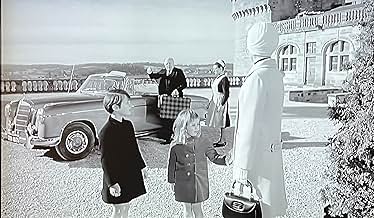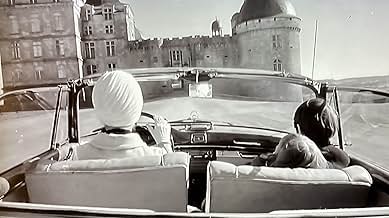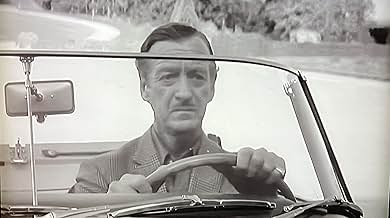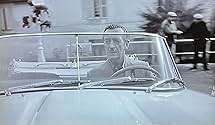CALIFICACIÓN DE IMDb
6.1/10
3.5 k
TU CALIFICACIÓN
Los trabajadores de un viñedo francés son parte de un antiguo culto pagano que requiere el sacrificio de la vida del marqués para salvar la cosecha en año de sequía.Los trabajadores de un viñedo francés son parte de un antiguo culto pagano que requiere el sacrificio de la vida del marqués para salvar la cosecha en año de sequía.Los trabajadores de un viñedo francés son parte de un antiguo culto pagano que requiere el sacrificio de la vida del marqués para salvar la cosecha en año de sequía.
- Dirección
- Guionistas
- Elenco
Chris Adcock
- Villager
- (sin créditos)
Hyma Beckley
- Villager
- (sin créditos)
Olwen Brookes
- Party Guest
- (sin créditos)
Opiniones destacadas
Why do the makers of movies very often think that they are better than the author of the original text? A lot of important details from the novel have been simply left out, the structure has been altered, the characters modified. One should really read the novel first to understand the contest.
Good cast, good director (J. Lee Thompson)...so what went wrong? Despite a sumptuous production and handsome locales, thriller about an ancient French estate needing a human sacrifice to restore life to the dying grape vineyards is frantic and confusing. The editing is such a hodgepodge, it's as though the negative got crammed into a blender. How else to explain the total lack of character content, the muddled continuity, or the perplexing plot itself? Also referred to as "13", the title-switcheroo proved unlucky for everyone, maybe most especially Sharon Tate (who does look gorgeous and has one neat scene where she changes a toad into a dove). Tate wanders through the film in a passive fog, and is later the victim to a whip-snapper; she gets an 'introducing' credit here, just as she did for 1967's "Don't Make Waves", though neither film is memorable nor uses her adequately. Poor miscast David Niven has nasty bags under his eyes, and his repartee with old friend Deborah Kerr (brought in after Kim Novak was either let go or dropped out) has no nuances--they seem like strangers. ** from ****
Okay spooker is missing some important back-story that would make it more compelling. Niven is disengaged in the lead, leaving a slackness to the main thrust of the movie but Deborah Kerr is suitably panicked as the questioning wife. What a supporting cast though! Flora Robson, Edward Mulhare, Emlyn Williams all contribute little bits of color and Donald Pleasance is ideally cast as an ominous presence who keeps popping, up his liquid eyes betraying nothing but giving the viewer the creeps nonetheless. David Hemmings has little to do but stare into the distance and give off an unpleasant vibe which he does well while being disturbing in his beauty. Speaking of beauty, this was Sharon Tate's first big role in her regrettably short career and she gets the corresponding introducing credit , man alive was she breathtaking! She gives an appropriate performance all glacial looks and dreamy line readings, the part doesn't demand more than that. But the camera loved her and when she's on screen you look at no one else, a vital component of a star. Would she have achieved that position? Who knows but the ingredients where definitely there. The black & white photography is most evocative and was a wise choice to set the proper tone for the piece. Not a great film by any means but a decent view near Halloween.
It certainly has all the ingredients to make this a classic, but fails to make it through for me, despite the pretty impressive cast.
It does bring to mind the Deborah Kerr cult movie The Innocents, but doesn't quite get there. All the components are here, but I thought the lack of pacing of the film made this less effective entertainment.
It is interesting nonetheless if you can take the slower pace. The outside shots mostly take advantage of the set location in France in a castle or chateau, which adds to the atmosphere quite well. The film does have the feel though of being filmed the earlier 1960's, rather than in the second half, with the camera angles etc i.e. close up of the actor to the side of the shot with the action/plot developing in the distance. It's shot in black and white which works very well, just at this time in cinema, there was the colour explosion going on.
The two "youngsters" here, David Hemmings (died blond hair) and Sharon Tate certainly look good, which is handy, as they do not appear to have many lines. They mostly go for the quiet manacing look school of acting here.
For those who like a bit of S&M, Sharon Tate gets a whipping and seems to like it, but don't expect too much, and that includes any erotic scenes or nudity. Just as well, as they are not needed, although it may have made the film slightly more interesting if tastefully done.
Sharon goes through the film looking like a model here in nearly all of her screen time. Donald Pleasance is Donald Pleasance who gives most of his best acting with his eyes, and does not have the lines or role to make his performance more memorable, which is a shame. As to David Niven's performance, it was good enough, but no particular plaudits from me (or criticism). Deborah Kerr is quite good, and is trying reasonably hard I thought, as did Flora Robson.
It's a 60's, B/W film, driven by a pagan plot with the usual accoutrement's (monks in hoods etc), and if that is your thing then give it a go. Not an out and out classic, but is worthy of being mentioned with the best of this genre, and more as an interesting flawed cult movie for horror fans.
It does bring to mind the Deborah Kerr cult movie The Innocents, but doesn't quite get there. All the components are here, but I thought the lack of pacing of the film made this less effective entertainment.
It is interesting nonetheless if you can take the slower pace. The outside shots mostly take advantage of the set location in France in a castle or chateau, which adds to the atmosphere quite well. The film does have the feel though of being filmed the earlier 1960's, rather than in the second half, with the camera angles etc i.e. close up of the actor to the side of the shot with the action/plot developing in the distance. It's shot in black and white which works very well, just at this time in cinema, there was the colour explosion going on.
The two "youngsters" here, David Hemmings (died blond hair) and Sharon Tate certainly look good, which is handy, as they do not appear to have many lines. They mostly go for the quiet manacing look school of acting here.
For those who like a bit of S&M, Sharon Tate gets a whipping and seems to like it, but don't expect too much, and that includes any erotic scenes or nudity. Just as well, as they are not needed, although it may have made the film slightly more interesting if tastefully done.
Sharon goes through the film looking like a model here in nearly all of her screen time. Donald Pleasance is Donald Pleasance who gives most of his best acting with his eyes, and does not have the lines or role to make his performance more memorable, which is a shame. As to David Niven's performance, it was good enough, but no particular plaudits from me (or criticism). Deborah Kerr is quite good, and is trying reasonably hard I thought, as did Flora Robson.
It's a 60's, B/W film, driven by a pagan plot with the usual accoutrement's (monks in hoods etc), and if that is your thing then give it a go. Not an out and out classic, but is worthy of being mentioned with the best of this genre, and more as an interesting flawed cult movie for horror fans.
Curiously solid, little occult psychological thriller that's sinisterly gloomy and consists of a banged-up ensemble cast featuring names like David Niven, Deborah Kerr, Donald Pleasance, David Hemming and Sharon Tate. A wealthy French nobleman returns back to his home town, along with his wife and children to help out with the town's failing vineyard. When there he tries to keep it secret from his wife, but she soon discovers the family tradition of Pagan sacrifice . The professionally classy performances are fitting, especially the support roles with Hemming and Tate really embellishing a creepy presence. Same for a cold-glazed Pleasance. Director J. Lee Thompson's atmospheric touch shows in many frames of this crisp b/w presentation, from the spooky castle, to the watching townsfolk and a disorientating chase scene through the castles nearby forest. It's attractively photographed, where Thompson also goes about providing some frenetic camera angles to lay out the anxiety of the circumstances. Despite some short-lived pockets, tension seems to be replaced by glum atmospherics in what feels like a slow-burn mood piece with a stringently compounded script breathing plenty of mystery and intrigue from that dark secret formula. Some things are not entirely explained, but it gives in to a devilish ending, but it's a very long build up to its foreseeable payoff. Some motions and actions of Kerr's concerned, but caring mother figure were somewhat an irritation. Niven is fine as the man tormented by his ancestral responsibilities, but it doesn't ask too much from him. While Kerr was the opposite with her emotive turn. The music score is melodically haunting in its angelic cues. A wickedly sleepy black mass thriller.
"Drive out of this valley. Never come back.".
"Drive out of this valley. Never come back.".
¿Sabías que…?
- TriviaThis movie spent a long time on the shelf. Filming was completed in the early part of 1966, but its American release was not until late 1967, and its British one not until the spring of 1968. David Hemmings made this movie before his breakthrough role in Blow-Up. Deseo de una mañana de verano (1966), and it is quite possible that the great (and unexpected) popularity of that movie was what finally pushed MGM into releasing this one. Many commented with surprise on the smallness of Hemmings' role - it is likely that his special billing, along with that of Sharon Tate, was an afterthought to disguise the fact that they had supporting parts. Although this movie was supposed to launch Tate, she had, because of its protracted shelf-life, already been seen in No hagan olas (1967), which she had made subsequently. That movie has a special "introducing" credit for her as a result.
- ErroresDavid Niven's character, Philippe, goes to a vineyard to inspect grapes, wearing a blazer with a button-down oxford underneath. After a cutaway scene to a different character, the view returns to Philippe in the vineyard. He is still wearing the same oxford but now he has a covering sweater-vest on instead of the blazer.
- Citas
Philippe de Montfaucon: Believe it, Catherine.
Catherine de Montfaucon: I just told you, I don't!
Philippe de Montfaucon: Believe it. Believe it. Believe it. Or leave here.
- Créditos curiososThe Turner print has the main title as "Eye of the Devil" but the ending credit lists the title as "13".
- Versiones alternativasThe "Turner" print uses "Eye of the Devil" as the main title; but, the end credit lists the title as "13". This print has a running time of 95 minutes.
- ConexionesEdited into Inside the Manson Gang (2007)
Selecciones populares
Inicia sesión para calificar y agrega a la lista de videos para obtener recomendaciones personalizadas
- How long is Eye of the Devil?Con tecnología de Alexa
- Is Philippe de Montfaucon and his family supposed to be French?
Detalles
Taquilla
- Presupuesto
- USD 3,000,000 (estimado)
- Total a nivel mundial
- USD 4,966
- Tiempo de ejecución1 hora 36 minutos
- Color
- Relación de aspecto
- 1.66 : 1
Contribuir a esta página
Sugiere una edición o agrega el contenido que falta

Principales brechas de datos
What is the Brazilian Portuguese language plot outline for El signo del diablo (1966)?
Responda





























